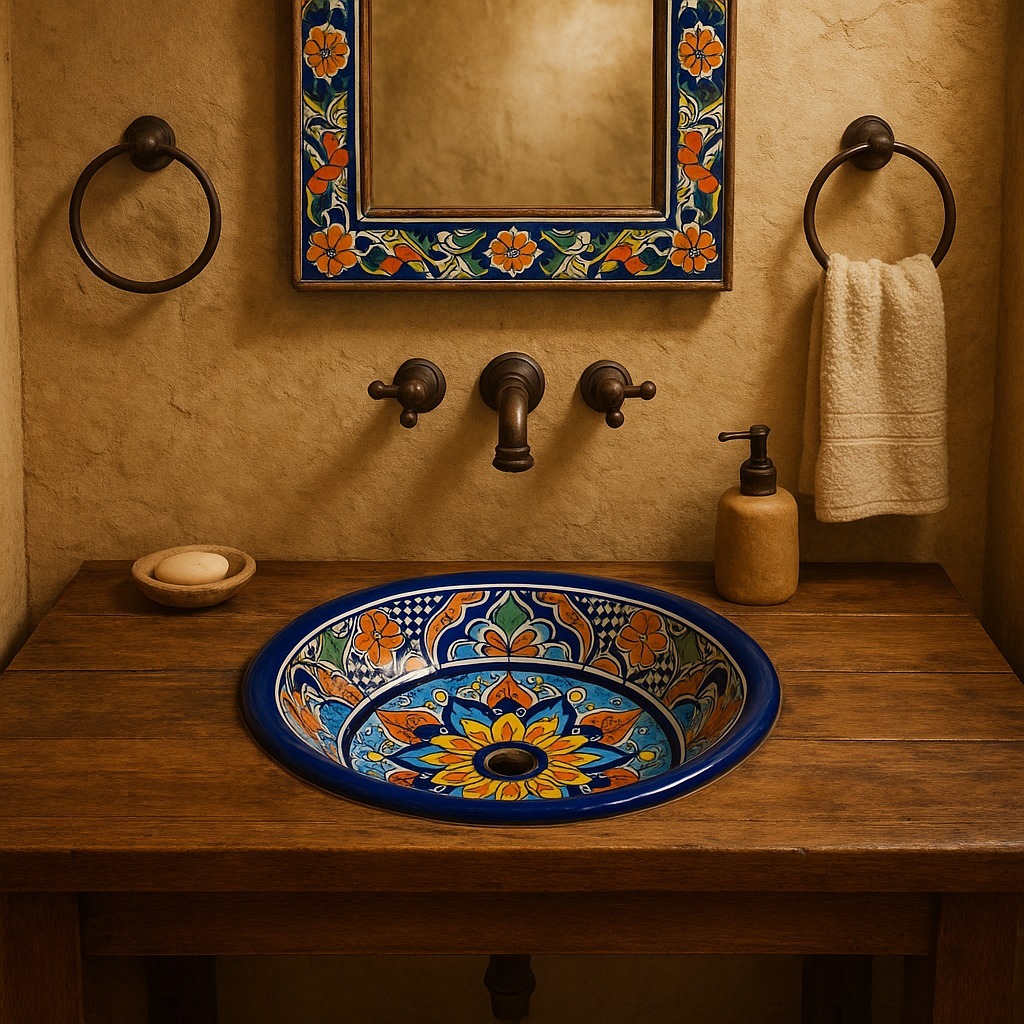The Art and Heritage of Mexican Bathroom Sinks: A Cultural Masterpiece for Your Home
In the world of home décor, where trends often come and go, few design elements have the timeless appeal and cultural richness of Mexican bathroom sinks. These handcrafted pieces are more than just functional fixtures; they are works of art rooted in centuries-old traditions. Blending vibrant colors, symbolic motifs, and artisanal techniques, Mexican sinks—particularly Talavera—bring character and history to modern interiors. But what makes them truly special? In this article, we explore the story, artistry, and significance behind Mexican ceramic sinks, offering a deep appreciation for their cultural and design value.
Origins of Talavera: A Fusion of Cultures

The story of Talavera pottery begins in the 16th century, shortly after the Spanish colonization of Mexico. Spanish artisans introduced tin-glazed pottery techniques to the region, especially in Puebla—a city that quickly became the epicenter of this new ceramic tradition. Drawing on Moorish, Italian, and indigenous influences, local potters began crafting brightly colored ceramics that were both decorative and utilitarian.
Over time, the pottery developed a uniquely Mexican identity, now officially recognized as “Talavera de Puebla.” Today, this pottery is protected by a Denomination of Origin status, ensuring that true Talavera pieces are made in specific regions using traditional techniques. This cultural heritage is embedded in every Talavera bathroom sink, where artistry meets daily living.
Why Talavera Bathroom Sinks Are Unique
Each Talavera sink is individually handcrafted using natural clay from Puebla and surrounding areas. The process is meticulous and often takes several weeks to complete. Artisans first mold the clay by hand or on a potter’s wheel, then fire it at high temperatures to create a durable ceramic base. After the initial firing, the sink is coated with a tin-based glaze and hand-painted with intricate designs, often inspired by floral, animal, or geometric motifs.
The final product is not just a sink—it’s a statement. Every piece is one-of-a-kind, with slight variations in pattern and color that highlight its handmade origin. These characteristics appeal to homeowners and designers who value authenticity, craftsmanship, and heritage in their living spaces.
The Symbolism Behind the Patterns
The decorative patterns found on Talavera sinks are not merely aesthetic; they often carry symbolic meanings rooted in Mexican history and folklore. For instance, floral motifs like marigolds are associated with life and celebration in Mexican culture, especially during Dia de los Muertos. Birds represent freedom, nature, and spiritual harmony, while geometric designs reflect the mathematical precision and artistry of pre-Hispanic civilizations.
By incorporating these symbols into your bathroom, you're not just enhancing visual appeal—you’re also embracing centuries of cultural storytelling and artistic expression. It’s no surprise that designers and collectors consider these sinks functional pieces of folk art.
Where Craftsmanship Meets Daily Life
Unlike mass-produced bathroom fixtures, each Mexican ceramic sink is a tactile reminder of human artistry. The brushstrokes of the artisan are often visible beneath the glaze, telling a story of hands that shape, paint, and perfect each design. This physical connection between creator and user gives every sink a soul—transforming the act of washing your hands into a small, daily encounter with culture.
Whether installed in rustic, eclectic, or Southwestern-style bathrooms, Talavera sinks bring a unique texture and vibrancy to a home. Their bright hues and expressive patterns make them a focal point—drawing compliments and admiration from guests while grounding the space in a deeper cultural narrative.
The Artistic Process: From Clay to Finished Sink
The creation of a Mexican Talavera sink is a labor of love, passed down through generations. Here's a brief look at the process:
- Clay Preparation: Artisans source local clay and mix it with water, kneading it to remove air bubbles and achieve the right consistency.
- Shaping: The sink is shaped by hand or mold and left to dry for several days.
- First Firing: Once dry, the piece undergoes a first firing in a kiln to harden the clay.
- Glazing: A white tin-based glaze is applied, providing the base for vibrant colors.
- Hand-Painting: Skilled artisans use mineral-based pigments to create detailed motifs—freehand and without templates.
- Second Firing: The sink is fired again at high temperatures to fuse the glaze and paint, creating a durable, glossy finish.
This handcrafted journey ensures that each sink is rich in personality, color depth, and durability. You can view a wide range of these masterpieces at Mexican Tile Store, where craftsmanship and authenticity are celebrated.
Blending Old World with Modern Design
One of the most compelling aspects of Mexican ceramic sinks is their adaptability. Despite their deep historical roots, Talavera sinks integrate beautifully with contemporary interiors. Pair them with minimalist fixtures for a bold contrast or with antique mirrors and wood vanities to evoke an Old-World atmosphere.
Designers often use Talavera sinks as a launch point for styling an entire bathroom. Their vivid blues, yellows, greens, and terracottas inspire choices in tiles, lighting, and accessories. This makes them an ideal choice for eclectic homeowners or anyone seeking a meaningful upgrade that combines visual impact with cultural significance.
Sustainable and Local: A Responsible Design Choice
Buying a handcrafted Talavera sink supports sustainable, small-scale craftsmanship and local economies. These pieces are made using eco-conscious methods with minimal environmental impact. Many artisans use recycled materials for packaging, and the production process consumes far less energy than industrial manufacturing.
By choosing handmade sinks from regions like Puebla, you're not only investing in a beautiful bathroom upgrade, you're also contributing to the preservation of artisanal traditions and responsible commerce. Platforms like Mexican Tile Store play a crucial role in connecting global customers with local makers.
Tips for Incorporating Mexican Sinks in Your Bathroom
Here are some ideas to get the most out of your Talavera bathroom sink:
- Coordinate with Tiles: Choose hand-painted Mexican tiles for your backsplash to echo the sink’s colors and motifs.
- Choose the Right Faucet: Opt for oil-rubbed bronze or antique brass to enhance the rustic charm.
- Contrast or Match: Use a neutral countertop for contrast, or go bold with a vibrant, tiled vanity.
- Accent Lighting: Install warm-toned lighting to highlight the rich colors of the glaze.
For more inspiration and to explore available styles, visit the full collection at Mexican Talavera Bathroom Sinks.
A Functional Piece of Living Art
In a world where so much is mass-produced and digitally rendered, Mexican Talavera bathroom sinks remain proudly analog. Every brushstroke, every imperfection, every unique pattern is evidence of a person behind the process. These are not just sinks; they are cultural storytellers, heirlooms in the making, and vibrant reflections of Mexican creativity.
Whether you’re restoring a hacienda, decorating a desert retreat, or simply adding personality to a guest bathroom, a Talavera sink is more than an aesthetic choice—it’s a connection to heritage. As demand for meaningful, artisanal decor grows, Talavera sinks stand as a brilliant intersection of utility and soul.
Ready to Bring Cultural Craftsmanship into Your Home?
If you're looking to enrich your home with authenticity, color, and history, start with the bathroom. Explore the diverse and stunning collection of hand-painted Mexican ceramic sinks at Mexican Tile Store, where tradition meets timeless beauty.



